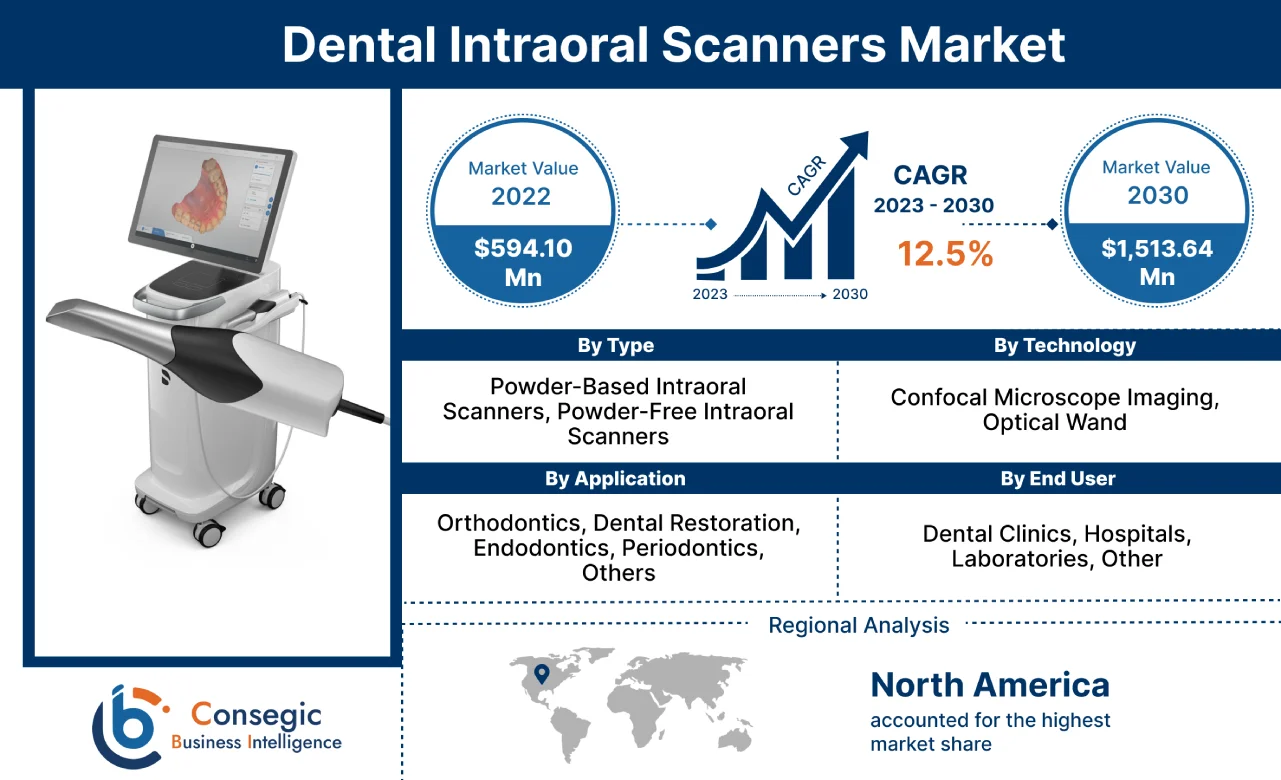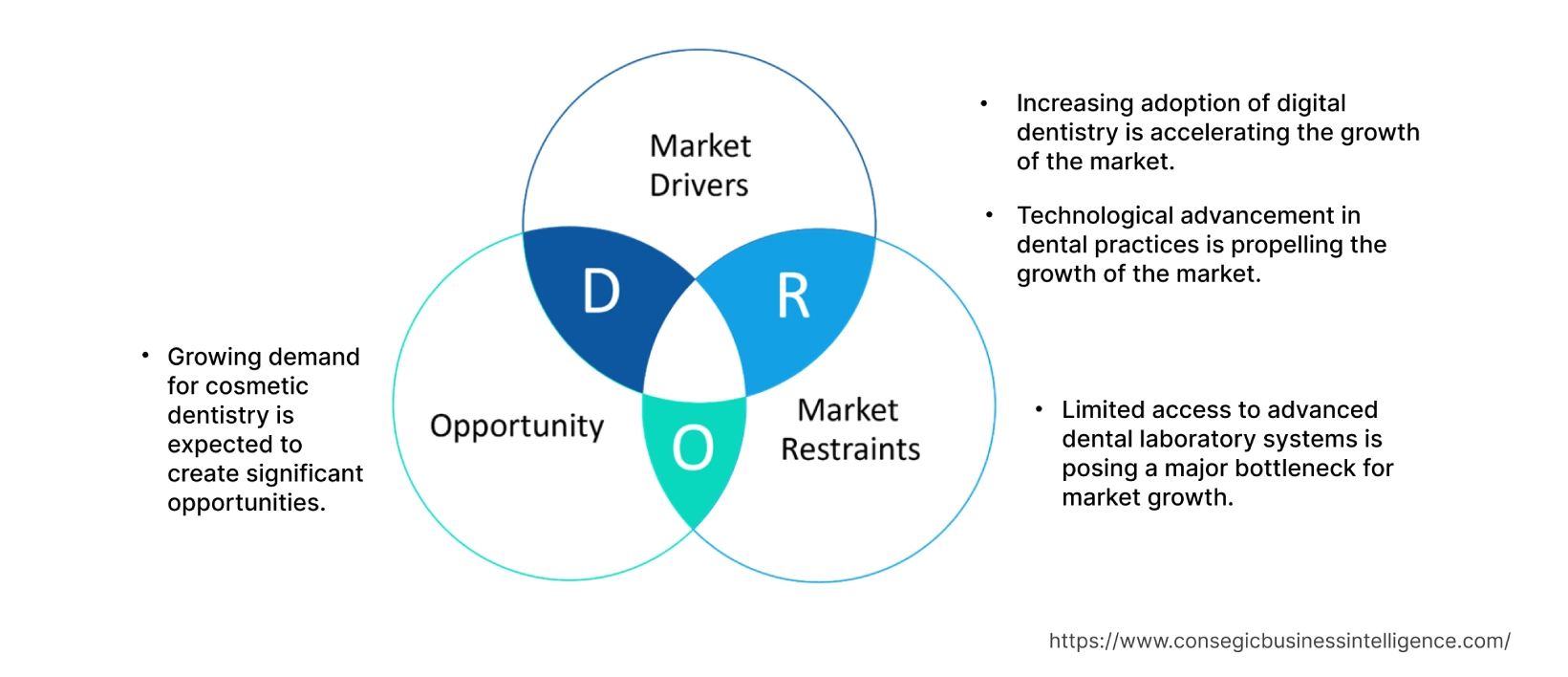- Summary
- Table Of Content
- Methodology
Dental Intraoral Scanners Market Scope & Overview:
A dental intraoral scanners is a handheld device used to create digital impressions of the teeth and gums. It is a digital alternative to the traditional method of taking impressions using a tray and alginate or polyvinyl siloxane material. It creates an immediate 3D impression of gums, teeth, and dental bite on the screen that can be viewed by both patient and dentist on a chairside screen in real-time.
Dental intraoral scanners becoming increasingly popular in dentistry and are used for a variety of procedures, including crowns, bridges, implants, and orthodontics. Dental intraoral scanners are becoming the tool of choice among dentists and patients due to the quick lab turnaround times in the procedure.
Dental Intraoral Scanners Market Size :
Dental intraoral scanners market is projected to be valued at USD 1,513.64 Million by 2030, and growing with a CAGR of 12.5% during the forecast period (2023-2030).
Dental Intraoral Scanners Market Insights :
Dental Intraoral Scanners Market Dynamics - (DRO) :
Key Drivers :
Increasing adoption of digital dentistry is accelerating the growth of the market
Dental intraoral scanners are a key part of digital dentistry. Digital dentistry is a broad term that refers to the use of digital technology in dentistry. The dental industry is rapidly shifting towards digital dentistry, which involves the use of advanced technology for diagnosis, treatment, planning, and fabrication of dental restoration. Dental intraoral scanners play a vital role in this digital workflow by capturing accurate and detailed 3D scans of the patient's teeth and gums.
For instance, in January 2022, a report published by the Institute of Digital Dentistry that the adoption of Intraoral scanners was dramatically accelerated in 2021 and will continue into 2022. Additionally, the Penetration of the use of dental intraoral scanners is about 30-35% in the US. For this reason, the increasing adoption of digital dentistry is accelerating the growth of the market.
Technological advancement in dental practices is propelling the growth of the market
The dental intraoral scanner market is constantly evolving and witnessing technological advancements. Manufacturers are developing scanners with improved accuracy, faster scanning speed, and enhanced image resolution. Also introducing additional features such as color mapping and augmented reality.
These technological advancements are driving the adoption of dental intraoral scanners as dentists and dental laboratories seek to leverage the latest innovations in their practices. For instance, in February 2021, Align Technology, Inc. announced the launch of iTero Element Plus Series intraoral scanners.
The innovative intraoral scanner model by Alighn Technology Inc. provides comprehensive restorative and orthodontic digital capabilities for dentists. Thus, above mentioned trend and increasing adoption of advanced technology in dentistry practices the growth of the dental intraoral scanners market is driving.
Key Restraints :
Limited access to advanced dental laboratory systems is posing a major bottleneck for market growth
Dental intraoral scanners are often used in conjunction with Computer-aided design (CAD) and Computer-aided manufacturing (CAM). However, not all dental clinics and practices have access to such advanced laboratories, or the expertise required for digital workflow. There are some limitations to the use of dental intraoral scanners in areas with limited access to advanced dental laboratories.
For example, if a dentist needs to create a complex dental restoration, they may need to send the digital data to a dental laboratory that has the expertise and equipment to fabricate the restoration. This can add to the cost and time of the treatment. This limited access can hinder the adoption of intraoral scanners in some regions or smaller dental practices, thereby restraining the growth of the dental intraoral scanner market.
Future Opportunities :
Growing demand for cosmetic dentistry is expected to create significant opportunities
Dental intraoral scanners are increasingly being used in cosmetic dentistry to create digital impressions of the teeth and gums. This data can then be used to design and fabricate crowns, veneers, bridges, and other dental restorations. The demand for cosmetic dentistry procedures such as veneers, crowns, and orthodontics aligners., is increasing globally.
Intraoral scanners play a crucial role in digital design and the fabrication of aesthetic restoration. For instance, in 2022 as per the report published by the National Library of Medicine 90.7% of dental practitioners believed that there is an increased demand for aesthetic dental procedures due to the influence of social media. For this reason, the growing demand for cosmetic dentistry is expected to create significant opportunities.
Top Key Players & Market Share Insights:
The dental intraoral scanner market is highly competitive, with several large players and numerous small and medium-sized enterprises. These companies have strong research and development capabilities and a strong presence in the market through their extensive product portfolios and distribution networks. The market is characterized by intense competition, with companies focusing on expanding their product offerings and increasing their market share through mergers, acquisitions, and partnerships. The key players in the market include-
- 3Shape A/S
- Align Technology, Inc.
- Guangdong Launca Medical Device Technology Co. Ltd.
- Midmark Corporation
- Planmeca OY
- Condor Technologies NV
- Densys3D Ltd.
- Dental Wings Inc.
- Dentsply Sirona Inc.
- Envista Holdings Corporation
Dental Intraoral Scanners Market Segmental Analysis :
By Type :
The type segment is segmented into powder-based intraoral scanners and powder-free intraoral scanners. In 2022, powder-free intraoral scanners segment accounted for the highest market share in the overall dental intraoral scanners market and growing with the highest CAGR in the forecast year. The factors such as ease of operating powder-free dental intraoral scanners. Powder-free intraoral scanners require fewer processing steps which makes the process quick and easy. For instance, as per the article published by Medit Corp. in 2022, using a powder-free system makes digital impression-taking much faster and reduces chair time by more than 20%. Which in turn improved the overall experience for both dentist and patient. Furthermore, increasing demand for powder-free intraoral scanners is driving the growth of the market.
By Technology :
The technology segment is divided into confocal microscope imaging, and optical wand. In 2022, the confocal microscope imaging segment accounted for the highest market share in the dental intraoral scanners market and grew with the highest CAGR in the forecast year. The confocal microscope is a highly quantitative tool, capable of collecting high-quality multispectral images across the visible range due to which it has major demand in orthodontists and dental restoration in dentistry. For instance, as per the article published by ResearchGate, among various devices, confocal scanning microscopy is considered to be a valuable tool in dentistry. Furthermore, the increased adoption of confocal microscope imaging technology in dentistry practices is driving the growth of the market.
By Application :
The application segment is categorized into orthodontics, dental restoration, endodontics, periodontics, and others. The dental restoration segment accounted for the highest market share of 29.40% in the overall dental intraoral scanners market and growing with the highest CAGR in the forecast year. Intraoral scanner has been widely used in dental restoration as intraoral scanner provide precise digital dental impression for fabricating various prosthetic restoration such as single crown inlays/ onlays, dental copings, and fixed partial dentures on implants and teeth. For instance, in 2022, as per the data published by WHO, Untreated dental caries (tooth decay) in permanent teeth is the most common health condition according to the Global Burden of Disease 2019. Furthermore, the increasing number of patients for dental restoration has increased the use of intraoral scanners for the treatment of dental restoration including dental filling to restore the function of teeth.
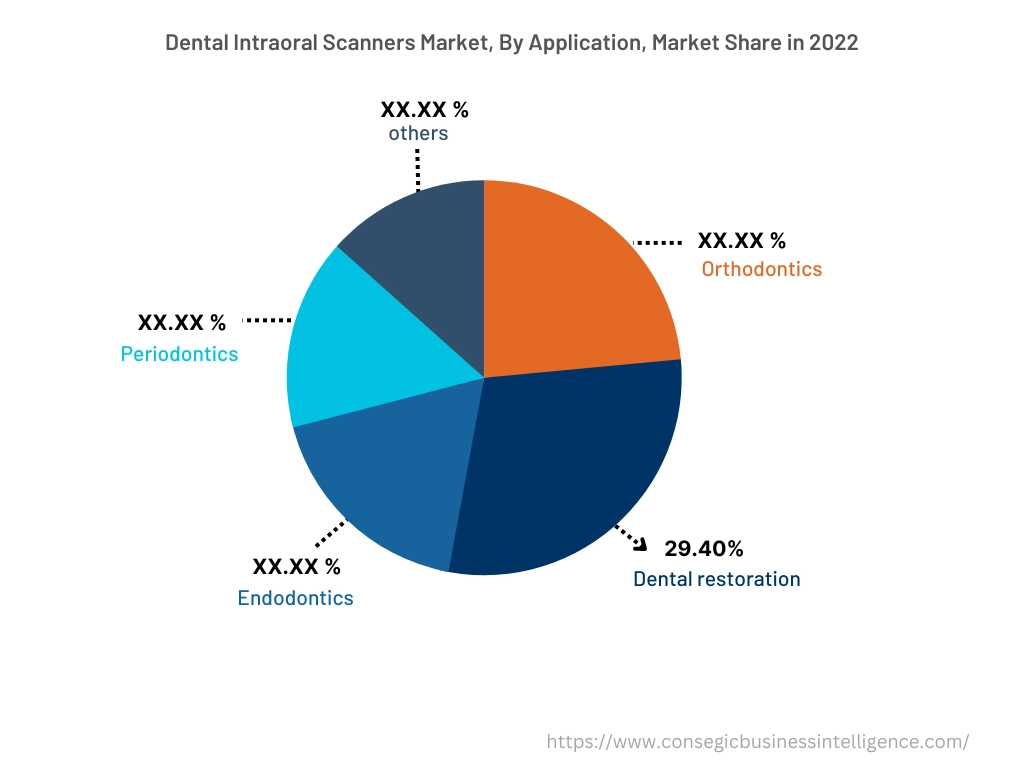
By End-User :
The end-user segment is categorized into dental clinics, hospitals, laboratories, and others. In 2022, the hospital segment accounted for the highest market share in the dental intraoral scanner market and grew with the highest CAGR in the forecast year. Due to improvements in infrastructure in hospitals, the rising number of multispecialty hospitals with trained professionals, and the adoption of new technology. Furthermore, the increasing number of patients visiting the hospitals due to primary care, availability of experienced consultants, and advanced equipment impact boost the demand for the hospital segment.
Dental Intraoral Scanners Market Report Insights :
| Report Attributes | Report Details |
| Study Timeline | 2017-2030 |
| Market Size in 2030 | USD 1,513.64 Million |
| CAGR (2023-2030) | 12.5% |
| By Type | Powder-Based Intraoral Scanners, Powder-Free Intraoral Scanners |
| By Technology | Confocal Microscope Imaging, Optical Wand |
| By Application | Orthodontics, Dental Restoration, Endodontics, Periodontics, Others |
| By End-User | Dental Clinics, Hospitals, Laboratories, Other |
| By Region | North America, Europe, Asia-Pacific, Latin America, and Middle East & Africa |
| Key Players | 3Shape A/S, Align Technology, Inc., Condor Technologies NV, Densys3D Ltd., Dental Wings Inc., Dentsply Sirona Inc., Envista Holdings Corporation, Guangdong Launca Medical Device, Technology Co. Ltd., Midmark Corporation, Planmeca OY |
By Region :
The regional segment includes North America, Europe, Asia Pacific, Middle East and Africa, and Latin America.
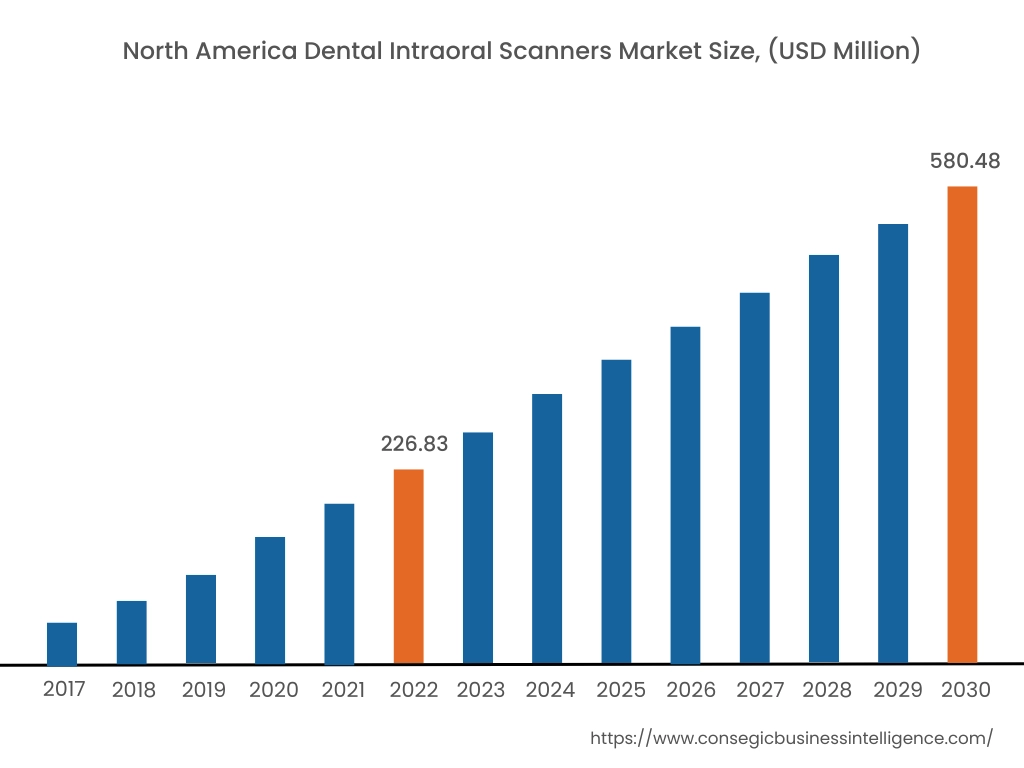
North America accounted for the highest market share of 38.18% and was valued at USD 226.83 million in 2022, and is expected to reach USD 580.48 million in 2030. In North America, the U.S. accounted for the highest market share of 38.18% during the base year of 2022. The major factors contributing to the growth of the region are rising cases of oral diseases. Presence of major market players and the use of the most advanced technology in dentistry. For instance, as per the National Institute of Dental and Craniofacial Research, around 90% of adults aged between 20 to 64 years have been affected by oral diseases in past years and 1 in 5 U.S. adults experiences moderate to high dental fear anxiety. Furthermore, other factors including increasing support from the government are driving the growth of the dental intraoral scanners market in the region.
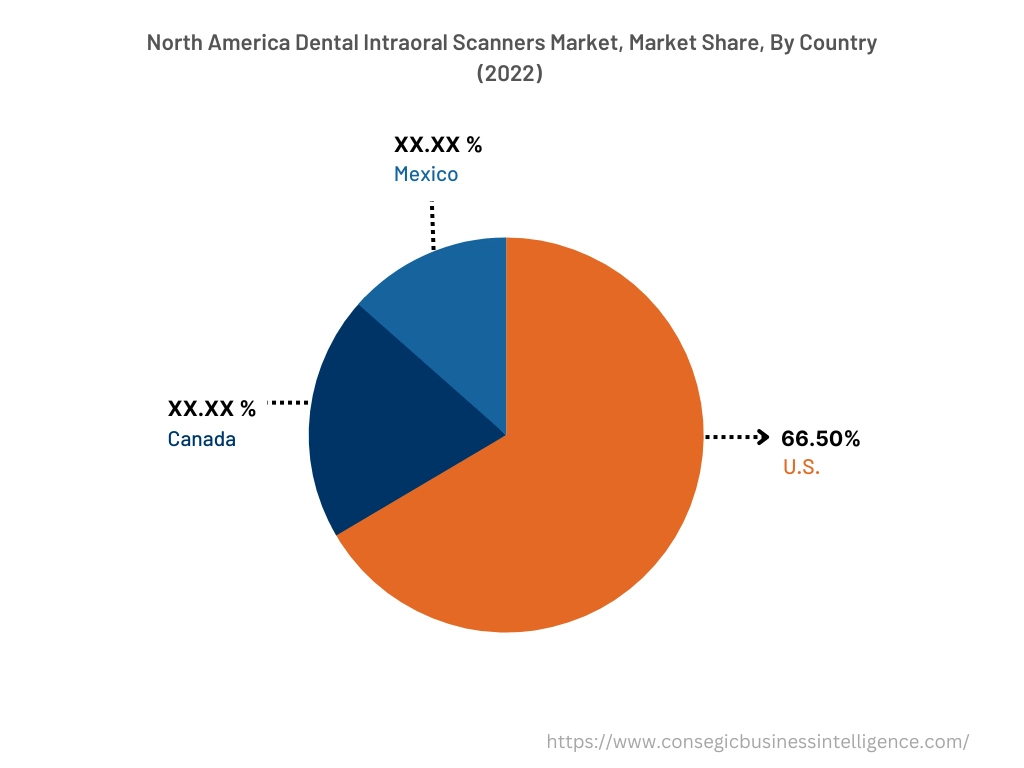
Recent Industry Developments :
- In September 2022, 3Shape launched TRIOS 5 Wireless, a completely new, state-of-the-art intraoral scanner designed to make it easier for dentists to do digital with their dentistry.
- In May 2022, Glidewell Partners with Medit to Launch the fastscan.io Intraoral Scanner. This new offering combines proven hardware and software to streamline digital dentistry workflows.
Key Questions Answered in the Report
What was the market size of the dental intraoral scanners in 2022? +
In 2022, the market size of dental intraoral scanners was USD 594.10 million
What will be the potential market valuation for dental intraoral scanners by 2030? +
In 2030, the market size of dental intraoral scanners will be expected to reach USD 1,513.64 million.
What are the key factors driving the growth of the dental intraoral scanners market? +
Increasing adoption of digital dentistry and technological advancement is driving the global dental intraoral scanners market growth.
What is the dominating segment in the dental intraoral scanner market by type? +
In 2022, the powder-free intraoral scanners segment accounted for the highest market share in the overall dental intraoral scanners market.
Based on current market trends and future predictions, which geographical region is the dominating region in the dental intraoral scanners market? +
North America accounted for the highest market share in the overall dental intraoral scanners market.
